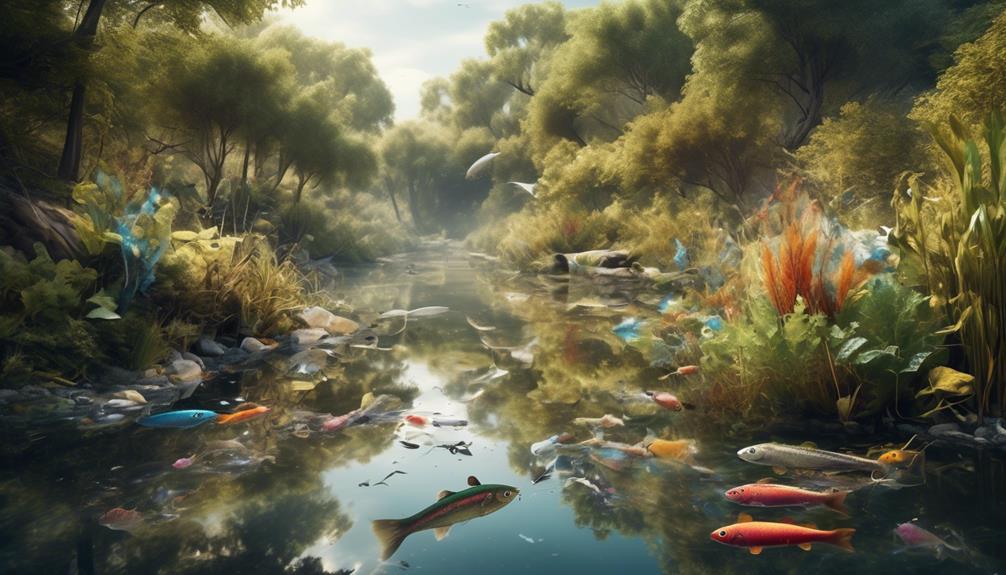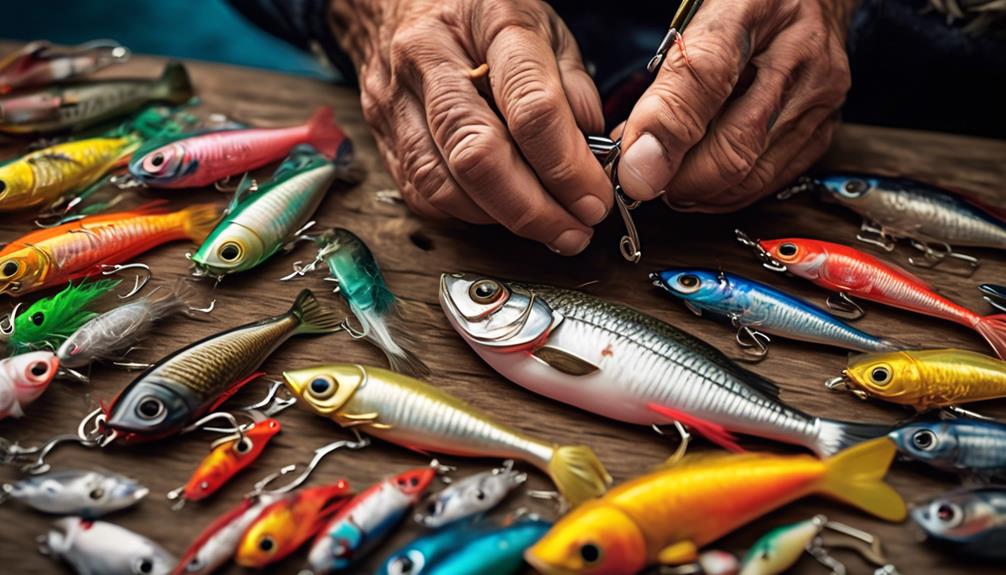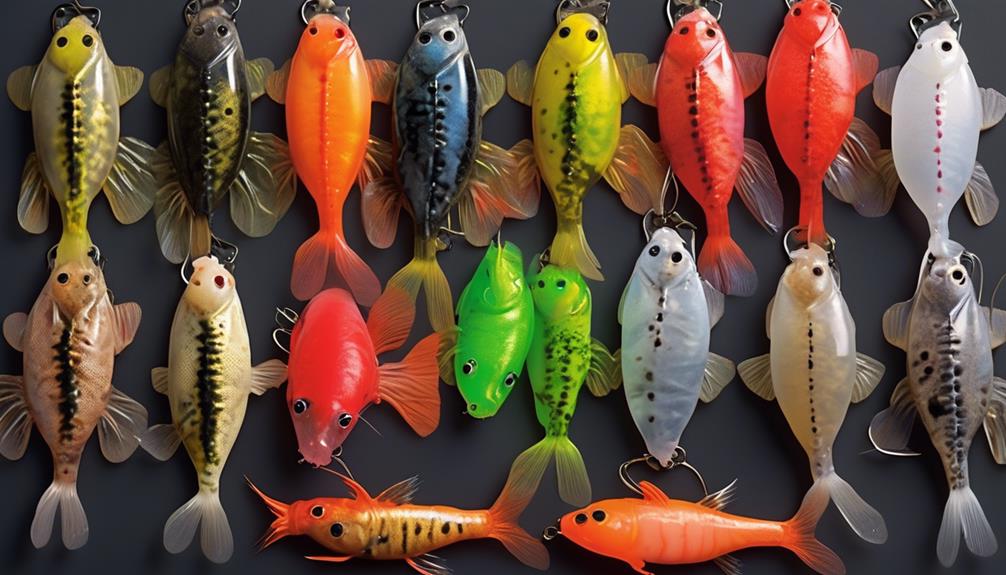You may not realize that artificial lures have been used for centuries, with evidence dating back to ancient Egypt. As an angler, you likely understand the importance of choosing the right gear to increase your chances of success on the water.
But have you considered all the pros and cons of using artificial lures? Whether you're a seasoned angler or just starting out, exploring the various aspects of artificial lures can help you make informed decisions about your fishing tackle.
From their effectiveness to their environmental impact, there are several factors to consider when deciding whether to incorporate artificial lures into your fishing arsenal.
Effectiveness
Artificial lures are generally effective at attracting fish due to their realistic appearance and enticing movements. When compared to live bait, artificial lures have the advantage of being able to mimic the movements of natural prey, making them highly appealing to various fish species. Additionally, artificial lures offer versatility in fishing techniques.
For instance, using topwater lures can be effective for targeting fish near the water's surface, while diving lures are excellent for reaching deeper depths where fish may be hiding. By understanding the different types of artificial lures and their applications, anglers can adapt their fishing techniques to suit various environments and fish behaviors.
Effectiveness comparison between artificial lures and live bait is an ongoing debate among anglers. While live bait has the advantage of natural scent and texture, artificial lures can outperform live bait in certain situations. For example, when fish are actively feeding on a specific type of prey, using a precisely designed artificial lure can yield better results than live bait. Furthermore, artificial lures excel in covering larger areas and can be retrieved at different speeds, allowing anglers to experiment with various presentations to entice fish.
Versatility
When adapting your fishing techniques to different environments and fish behaviors, versatility becomes a crucial factor in effectively targeting various species and maximizing your success. Artificial lures offer a range of benefits in terms of versatility, making them a valuable tool for anglers seeking to diversify their approach and adapt to changing conditions.
Here are some key aspects of versatility when it comes to artificial lures:
- Fishing Techniques: Artificial lures come in a wide variety of designs, each suited to different fishing techniques. Whether you prefer casting, trolling, jigging, or topwater presentations, there's a lure designed to accommodate your preferred method. This adaptability allows you to experiment with different techniques and find the most effective approach for the given conditions.
- Target Species: Versatility in lure design enables anglers to target a diverse range of species. Whether you're pursuing bass, trout, pike, or saltwater gamefish, there are artificial lures specifically tailored to attract each type of fish. This flexibility allows you to switch between target species without the need to change your entire setup, saving time and effort on the water.
- Water Conditions: Artificial lures can be tailored to suit specific water conditions, such as clear or murky waters, calm or rough surfaces, and various depths. This adaptability ensures that you can effectively fish in a wide range of environments, maximizing your chances of success regardless of the prevailing water conditions.
The versatility of artificial lures empowers you to adapt your fishing approach to the specific demands of different environments, target species, and water conditions, making them a valuable asset in your angling arsenal.
Realism
To enhance your chances of attracting fish, consider selecting artificial lures that closely mimic the appearance and behavior of natural prey. Realism is a crucial factor in the effectiveness of artificial lures. When it comes to realism application, the visual appeal of the lure plays a significant role in convincing the fish that it's real prey. By accurately replicating the look and movement of natural bait, artificial lures can trick fish into striking. This is especially important in clear water or when fish are feeding selectively on specific prey.
Artificial lures that closely resemble natural prey are more likely to elicit a strike from fish. The realistic appearance of these lures can trigger a feeding response from predatory fish, leading to more successful catches. Additionally, the behavior of the lure, such as the way it moves through the water, can further enhance its realism and effectiveness.
When selecting artificial lures, pay attention to the intricate details that contribute to their realism. Look for lures with lifelike eyes, natural color patterns, and realistic swimming actions. These features can make the lure appear more convincing to fish, increasing the likelihood of a successful catch.
On the other hand, overly exaggerated or unrealistic lures may not be as effective in enticing fish. While flashy and colorful lures can sometimes attract fish, a more realistic presentation often yields better results, especially in waters where fish are wary or highly selective. Therefore, considering the realism of artificial lures is crucial for maximizing your chances of a successful fishing trip.
Durability
Considering the amount of wear and tear your lures endure during fishing expeditions, it's essential to prioritize durability when selecting artificial lures. Here are some factors to consider when evaluating the durability of artificial lures:
- Material Composition: The longevity of artificial lures is heavily influenced by the materials used in their construction. Lures made from durable materials like hard plastics, metal, or high-quality rubber are more likely to withstand the rigors of frequent use without succumbing to damage. These materials are less prone to warping, cracking, or breaking, ensuring that the lures remain effective over an extended period.
- Wear and Tear: Artificial lures are subjected to significant wear and tear during fishing trips, especially when used in rugged or abrasive environments. Therefore, it's crucial to assess how well a lure can withstand this wear and tear without compromising its performance. Lures that can maintain their structural integrity and effectiveness despite repeated use in challenging conditions are highly desirable.
- Maintenance: The durability of artificial lures can also be influenced by the ease of maintenance. Lures that are easy to clean, repair, or modify are advantageous as they can be kept in top condition with minimal effort. Additionally, the ability to replace damaged or worn components can significantly extend the overall lifespan of the lure.
Prioritizing durability when selecting artificial lures ensures that you invest in products that can withstand the demands of fishing expeditions, ultimately providing better value for your money.
Cost
As you evaluate artificial lures for durability, the cost becomes a crucial factor in determining the overall value of your investment. Cost efficiency is essential when considering the purchase of artificial lures.
While artificial lures may have a higher initial cost compared to live bait, they can be more cost-effective in the long run due to their durability and reusability. When factoring in budget considerations, it's important to weigh the initial cost against the potential for extended use. High-quality artificial lures, although initially more expensive, can withstand multiple fishing trips, making them a cost-efficient choice over time.
On the other hand, budget considerations may lead some anglers to opt for cheaper artificial lures. While this may seem like a cost-effective choice in the short term, it's important to consider the durability and performance of lower-cost options. Cheaper lures may not withstand the rigors of frequent use and could result in the need for more frequent replacements, ultimately impacting their cost efficiency.
It's crucial to strike a balance between upfront cost and long-term value when making purchasing decisions.
Hooking Efficiency
When selecting artificial lures, it's crucial to ensure their hooking efficiency meets your fishing needs and preferences. The hooking efficiency of artificial lures can significantly impact your catch rates, making it essential to consider this aspect when choosing the right lures for your fishing endeavors.
Here are three ways to improve hooking efficiency and increase catch rates with artificial lures:
- Proper Hook Size and Placement: One way to enhance hooking efficiency is by selecting lures with the appropriate hook size and ensuring they're positioned correctly. This can involve using different hook sizes based on the type of fish you're targeting and adjusting the placement to maximize hooking potential.
- Enhanced Retrieval Techniques: Experimenting with various retrieval techniques can also contribute to improved hooking efficiency. Altering the speed, depth, and motion of your lure can make it more enticing to fish and increase the likelihood of a successful hookset.
- Utilizing Quality Lures: Investing in high-quality artificial lures can make a notable difference in hooking efficiency. Well-designed lures with sharp, durable hooks and realistic action can enhance your overall fishing experience by increasing the chances of hooking fish effectively.
Environmental Impact

To minimize the environmental impact of artificial lures, consider the materials and manufacturing processes used in their production. Many artificial lures are made of plastic, which can have a detrimental impact on wildlife. When lures are lost or discarded in water bodies, they can be mistaken for food by marine animals, leading to ingestion and potential harm. Additionally, the production of plastic lures contributes to pollution concerns, as the manufacturing process often involves the release of harmful chemicals and greenhouse gases.
Furthermore, the use of artificial lures can result in the entanglement of wildlife. Fishing lines and lures can pose a threat to birds, fish, and other aquatic creatures, leading to injuries or fatalities. This impact on wildlife is a significant concern when evaluating the environmental implications of using artificial lures for fishing.
It is important to be mindful of the environmental consequences associated with artificial lures and to take steps to mitigate their impact. Opting for lures made from biodegradable materials or choosing lures that are designed to be easily retrievable can help reduce the risk to wildlife and minimize pollution concerns. Additionally, properly disposing of old or damaged lures and fishing lines can prevent them from posing a threat to the environment and its inhabitants.
Learning Curve
Considering the potential challenges of using artificial lures, mastering their effective application can require a learning curve for anglers. This learning process involves skill development and practice needed to become proficient in using artificial lures.
Here are three key points to consider when navigating the learning curve of using artificial lures:
- Skill Development: Using artificial lures effectively requires honing specific skills such as casting accuracy, retrieval techniques, and understanding how different lures behave in varying water conditions. Beginners beware, as this process may take time and patience to develop the necessary skills for successful lure fishing.
- Learning Process: Embracing artificial lures involves understanding their diverse types, each designed to mimic different prey. From topwater lures to soft plastics, each requires a different approach and technique. This learning process also involves understanding the behavior of the target fish species and how they respond to different types of artificial lures.
- Practice Needed: The effectiveness of artificial lures is directly tied to the angler's ability to manipulate them in a lifelike manner, enticing fish to strike. This demands regular practice and experimentation to understand the nuances of each lure type and refine the angler's technique.
Navigating the learning curve of using artificial lures requires dedication to skill development, commitment to the learning process, and ample practice to achieve proficiency.
Frequently Asked Questions
Are There Any Specific Techniques or Tips for Using Artificial Lures Effectively in Different Fishing Conditions?
To use artificial lures effectively in different fishing conditions, consider the water clarity, temperature, and depth.
Vary your retrieval speed and experiment with different movements to mimic natural prey.
Adjust the lure selection based on the target species and the conditions. For example, use topwater lures in calm water and deep diving lures in deeper areas.
Stay observant and adaptable to maximize your success in various fishing conditions.
How Do Artificial Lures Compare to Live Bait in Terms of Attracting Different Types of Fish?
When it comes to attracting fish, artificial lures can be just as effective as live bait. Lure presentation is key, so mastering different fishing techniques and selecting the right lure for the conditions is crucial.
Artificial lures offer versatility and can mimic the movement of various prey, making them attractive to different types of fish. With the right skills and lure selection, you can definitely attract a wide range of fish using artificial lures.
Can Artificial Lures Be Used in Both Freshwater and Saltwater Fishing Environments?
Yes, artificial lures can be used in both freshwater and saltwater fishing. They're versatile and effective in various fishing conditions.
In freshwater, lures like spinners and crankbaits work well for targeting bass and trout.
In saltwater, lures such as jigs and soft plastics are effective for catching species like redfish and snook.
Understanding different artificial lure techniques will help you succeed in both environments.
What Are Some Common Maintenance Tips for Ensuring the Durability of Artificial Lures?
To ensure the durability of your artificial lures, follow these maintenance tips.
- Clean them regularly using mild soap and water.
- Inspect for damages and repair as needed.
- Store them in a dry, cool place to preserve materials.
- Test their durability by simulating fishing conditions.
- Consider waterproofing methods and protective coatings to enhance longevity.
These techniques will keep your lures in top shape for your fishing adventures.
Are There Any Potential Negative Environmental Impacts Associated With Using Artificial Lures, and How Can They Be Mitigated?
When using artificial lures, there are potential negative environmental impacts to consider. These may include littering water bodies and impacting fish habitats.
However, you can mitigate these effects by using biodegradable lures, properly disposing of damaged lures, and supporting sustainable fishing and conservation efforts.
Conclusion
In conclusion, artificial lures have their pros and cons. They're effective, versatile, and durable, but can be costly and have a negative environmental impact. They also require a learning curve to use effectively.
Ultimately, the decision to use artificial lures comes down to personal preference and fishing style. Consider these factors when choosing your fishing gear and decide what works best for you.



